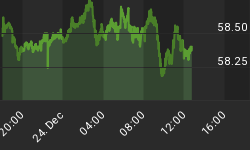For some reason I have received numerous questions from readers about the big advance seen on November 3rd by the Transports. The basic question that I'm being asked is whether or not that single 5% advance, as compared to the Industrials, had any predictive value from a Dow theory perspective. The short answer is no. From an orthodox Dow theory perspective, the magnitude of a move by one average verses the other average is immaterial as long as both averages are in gear with each other. When I say in gear, I mean as long as both averages are operating above or below their previous secondary high or low point.
With Dow theory, it is the joint movement of the Industrials and the Transports above and below previous secondary high and low points that matters. How much a previous secondary high or low point is penetrated is immaterial from a pure Dow theory perspective. Sure, we can argue that the greater the penetration the stronger the move, but from a pure Dow theory perspective, penetration by a fraction of a point is as good as penetration by 1 point, 100 points or even more. Now, Robert Rhea, the great Dow theorist of the 1930's did say that he preferred to see "penetration with velocity." By that he meant increased volume.
So, the fact that both averages are in gear to the upside above their previous secondary high points is all that matters at this time as the previously established primary bullish trend change from back in July still remains intact. The last closing high for the Industrials occurred on October 19th at 10,092.20 and on the Transports the last closing high occurred on October 20th at 4,045.11. The fact that the last closing highs occurred one day apart does not matter and does not constitute a non-confirmation.
In regard to the strength of one average versus the other, Robert Rhea wrote: "The two averages may vary in strength, but they will not vary materially in direction especially in a major movement. Throughout all the years in which both averages have been kept, this rule has proved entirely dependable. It is not only true in the major swings of the market, but it is approximately true of the secondary actions and rallies. It would not be true of the daily fluctuations, and it might be utterly misleading so far as individual stocks are concerned."
The current chart of the Industrials and the Transports can be found below:

Now, with that all being said, I must also report that nothing has changed with regard to this being a larger degree bear market rally that should ultimately prove to separate Phase I from Phase II of a much longer-term secular bear market. The key to identifying the top of this bear market rally will come from the statistics that I've data-mined going back to 1896, which was the inception of the Industrial and Transportation averages and which is covered in the monthly research letters. So, I know what this top should look like and between these statistics and the reading of the averages in accordance with orthodox Dow theory, I feel that I will be able to identify this bear market top. For now, the rally officially lives on. But, the longer it lasts the more people it will convince that it's a new bull market and the more people will ultimately be hurt in the end as the Phase II rally begins. This is why the Phase II declines are the most devastating.
I have begun doing free Friday market commentary that is available at www.cyclesman.info/Articles.htm so please begin joining me there. The specifics on Dow theory, my statistics, model expectations, and timing are available through a subscription to Cycles News & Views and the short-term updates. I have gone back to the inception of the Dow Jones Industrial Average in 1896 and identified the common traits associated with all major market tops. Thus, I know with a high degree of probability what this bear market rally top will look like and how to identify it. These details will be covered in the November research letters and will cover this in future letters and as this all unfolds. I also provide important turn point analysis using the unique Cycle Turn Indicator on the stock market, the dollar, bonds, gold, silver, oil, gasoline, the XAU and more. A subscription includes access to the monthly issues of Cycles News & Views covering the Dow theory, and very detailed statistical based analysis plus updates 3 times a week.
















